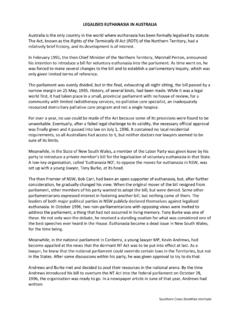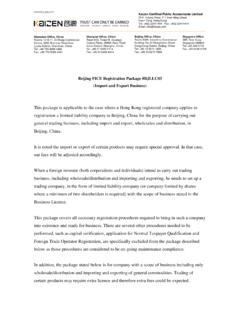Transcription of THE QUARTERLY JOURNAL OF ECONOMICS
1 THE. QUARTERLY JOURNAL . OF ECONOMICS . Vol. CXVI May 2001 Issue 2. THE IMPACT OF LEGALIZED ABORTION ON CRIME*. JOHN J. DONOHUE III AND STEVEN D. LEVITT. We offer evidence that legalized abortion has contributed signi cantly to recent crime reductions. Crime began to fall roughly eighteen years after abortion legalization. The ve states that allowed abortion in 1970 experienced declines earlier than the rest of the nation, which legalized in 1973 with Roe v. Wade. States with high abortion rates in the 1970s and 1980s experienced greater crime reductions in the 1990s. In high abortion states, only arrests of those born after abortion legalization fall relative to low abortion states. Legalized abortion ap- pears to account for as much as 50 percent of the recent drop in crime. I. INTRODUCTION. Since 1991, the United States has experienced the sharpest drop in murder rates since the end of Prohibition in 1933.
2 Homi- cide rates have fallen more than 40 percent. Violent crime and property crime have each declined more than 30 percent. Hun- dreds of articles discussing this change have appeared in the academic literature and popular They have offered an array of explanations: the increasing use of incarceration, growth * We would like to thank Ian Ayres, Gary Becker, Carl Bell, Alfred Blumstein, Jonathan Caulkins, Richard Craswell, George Fisher, Richard Freeman, James Heckman, Christine Jolls, Theodore Joyce, Louis Kaplow, Lawrence Katz, John Kennan, John Monahan, Casey Mulligan, Derek Neal, Eric Posner, Richard Posner, Sherwin Rosen, Steve Sailer, Jose Scheinkman, Peter Siegelman, Kenji Yoshino, and seminar participants too numerous to mention for helpful comments and discussions. Craig Estes and Rose Francis provided exceptionally valuable research assistance.
3 Correspondence can be addressed to either John Donohue, Crown Quadrangle, Stanford Law School, Stanford, CA 94305, or Steven Levitt, Department of ECONOMICS , University of Chicago, 1126 E. 59th Street, Chicago, IL. 60637. Email: 1. For a sampling of the academic literature, see Blumstein and Wallman [2000] and the articles appearing in the 1998 Summer issue (Volume 88) of the JOURNAL of Criminal Law and Criminology, especially Blumstein and Rosenfeld [1998], Kelling and Bratton [1998], and Donohue [1998]. See Butter eld [1997a, 2001 by the President and Fellows of Harvard College and the Massachusetts Institute of Technology. The QUARTERLY JOURNAL of ECONOMICS , May 2001. 379. 380 QUARTERLY JOURNAL OF ECONOMICS . in the number of police, improved policing strategies such as those adopted in New York, declines in the crack cocaine trade, the strong economy, and increased expenditures on victim pre- cautions such as security guards and alarms.]
4 None of these factors, however, can provide an entirely sat- isfactory explanation for the large, widespread, and persistent drop in crime in the 1990s. Some of these trends, such as the increasing scale of imprisonment, the rise in police, and expendi- tures on victim precaution, have been ongoing for over two de- cades, and thus cannot plausibly explain the recent abrupt im- provement in crime. Moreover, the widespread nature of the crime drop argues against explanations such as improved policing techniques since many cities that have not improved their police forces ( , Los Angeles) have nonetheless seen enormous crime declines. A similar argument holds for crack cocaine. Many areas of the country that have never had a pronounced crack trade (for instance, suburban and rural areas) have nonetheless experi- enced substantial decreases in crime.
5 Finally, although a strong economy is super cially consistent with the drop in crime since 1991, previous research has established only a weak link between economic performance and violent crime [Freeman 1995] and in one case even suggested that murder rates might vary procycli- cally [Ruhm 2000]. While acknowledging that all of these factors may have also served to dampen crime, we consider a novel explanation for the sudden crime drop of the 1990s: the decision to legalize abortion over a quarter century The Supreme Court's 1973 decision in Roe v. Wade legalizing abortion nationwide potentially ts the criteria for explaining a large, abrupt, and continuing decrease in crime. The sheer magnitude of the number of abortions performed satis es the rst criterion that any shock underlying the recent drop in crime must be substantial. Seven years after Roe v.
6 Wade, over million abortions were being performed annually al- most one abortion for every two live births. Moreover, the legal- 1997b, 1999] for a selection of articles appearing in The New York Times and Fletcher [2000] for a recent article in The Washington Post. 2. We are unaware of any scholarly article that has examined this effect. We have recently learned, however, that the former police chief of Minneapolis has written that abortion is arguably the only effective crime-prevention device adopted in this nation since the late 1960s [Bouza 1990]. In his subsequent 1994. gubernatorial campaign, Bouza was attacked for this opinion [Short 1994]. Im- mediately after Bouza's view was publicized just prior to the election, Bouza fell sharply in the polls. LEGALIZED ABORTION AND CRIME 381. ization of abortion in ve states in 1970, and then for the nation as a whole in 1973, were abrupt legal developments that might plausibly have a similarly abrupt in uence 15 20 years later when the cohorts born in the wake of liberalized abortion would start reaching their high-crime years.
7 Finally, any in uence of a change in abortion would impact crime cumulatively as succes- sive affected cohorts entered into their high-crime late adolescent years, providing a reason why crime has continued to fall year after year. Legalized abortion may lead to reduced crime either through reductions in cohort sizes or through lower per capita offending rates for affected cohorts. The smaller cohort that results from abortion legalization means that when that cohort reaches the late teens and twenties, there will be fewer young males in their highest-crime years, and thus less crime. More interesting and important is the possibility that children born after abortion legalization may on average have lower subsequent rates of crim- inality for either of two reasons. First, women who have abortions are those most at risk to give birth to children who would engage in criminal activity.
8 Teenagers, unmarried women, and the eco- nomically disadvantaged are all substantially more likely to seek abortions [Levine et al. 1996]. Recent studies have found children born to these mothers to be at higher risk for committing crime in adolescence [Comanor and Phillips 1999]. Gruber, Levine, and Staiger [1999], in the paper most similar to ours, document that the early life circumstances of those children on the margin of abortion are dif cult along many dimensions: infant mortality, growing up in a single-parent family, and experiencing poverty. Second, women may use abortion to optimize the timing of child- bearing. A given woman's ability to provide a nurturing environ- ment to a child can uctuate over time depending on the woman's age, education, and income, as well as the presence of a father in the child's life, whether the pregnancy is wanted, and any drug or alcohol abuse both in utero and after the birth.
9 Consequently, legalized abortion provides a woman the opportunity to delay childbearing if the current conditions are suboptimal. Even if lifetime fertility remains constant for all women, children are born into better environments, and future criminality is likely to be reduced. A number of anecdotal empirical facts support the existence and magnitude of the crime-reducing impact of abortion. First, we see a broad consistency with the timing of legalization of abortion 382 QUARTERLY JOURNAL OF ECONOMICS . and the subsequent drop in crime. For example, the peak ages for violent crime are roughly 18 24, and crime starts turning down around 1992, roughly the time at which the rst cohort born following Roe v. Wade would hit its criminal prime. Second, as we later demonstrate, the ve states that legalized abortion in 1970. saw drops in crime before the other 45 states and the District of Columbia, which did not allow abortions until the Supreme Court decision in 1973.
10 Third, our more formal analysis shows that higher rates of abortion in a state in the 1970s and early 1980s are strongly linked to lower crime over the period from 1985 to 1997. This nding is true after controlling for a variety of factors that in u- ence crime, such as the level of incarceration, the number of police, and measures of the state's economic well-being (the un- employment rate, income per capita, and poverty rate). The esti- mated magnitude of the impact of legalized abortion on crime is large. According to our estimates, as shown on Table II, states with high rates of abortion have experienced roughly a 30 percent drop in crime relative to low-abortion regions since 1985. While one must be cautious in extrapolating our results out of sample, the estimates suggest that legalized abortion can account for about half the observed decline in crime in the United States between 1991 and 1997.









